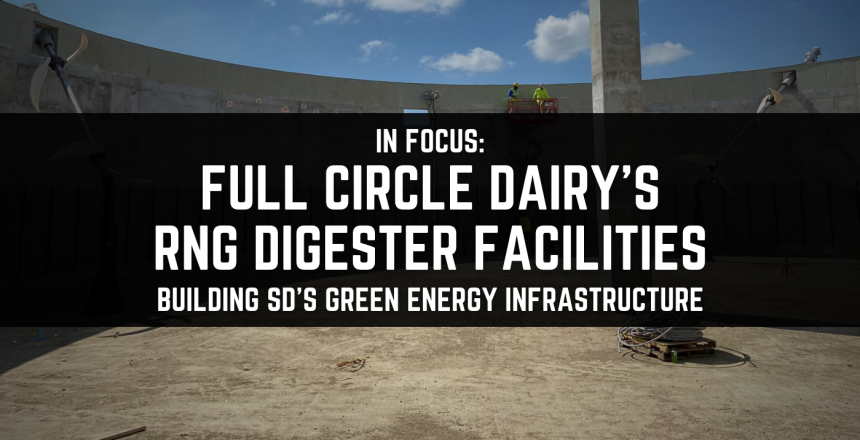In 2022, Brooks Construction began work on a new development near Hurley, SD, in partnership with Stockwell Engineers, Brightmark, and Biogest. Together, we broke ground on what would become the Full Circle Circularity Center, one of only a few RNG digester facilities near Sioux Falls, SD.
Today, the Full Circle Dairy Farms RNG Digester Facilities are up and running, and they’re producing more than renewable natural gas for this local dairy business.
What Are the Full Circle Dairy Farms RNG Digester Facilities?
When Full Circle Dairy began planning its operations, it needed a solution for managing cattle waste. Many dairies incorporate some form of slurry lagoon into their farm to manage manure, runoff water, and bedding materials like hay. Over time, that slurry decomposes into an organic fertilizer that can be used on the farm in place of chemical fertilizers.
But these lagoons carry some risks related to decomposition and the chances of injury to workers. Instead of a slurry lagoon, Full Circle’s owner sought a better solution: anaerobic digesters.
Digesters store and process slurry into fertilizer, but they provide more benefits than conventional lagoons by capturing the gases produced by decomposition to make biogas. This renewable natural gas, or RNG, is then sent into a pipeline system for future use.
For Full Circle’s RNG digester facilities, we built four 105-foot-diameter digester tanks with a total capacity 4.8 million gallons of cattle slurry. Every year, these manure digesters will convert around 332,000 tons of cattle slurry into around 155,700 MMBTu of renewable natural gas.
Along with the four digester tanks, the facility also has two 36-foot-diameter receiving tanks for raw slurry and one 41-foot-diameter digestate tank.
Challenges of the Full Circle Project
With the four digester tanks measuring 26 feet tall and over 100 feet in diameter, Full Circle Dairy required experienced teams to safely build the structures. The concrete work needed careful planning, but with specialized tools and skilled workers, it came together quickly.
Concrete Requirements
The scale of a project like this is hard to fathom, but with 7,000 head of dairy cattle, Full Circle needed massive RNG digester facilities. We brought in around 70 fully loaded concrete trucks throughout construction—around 7,000 cubic yards of concrete. For scale, a single-family home typically requires around 700 cubic yards of concrete for the foundation, basement, driveway, and sidewalks.
Rebar Fabrication
The height of the walls presents a challenge for both the fabrication of the rebar and the safety of the crews. Our crew members came in with extensive experience in rebar fabrication for structures of this scale, making it possible to safely build the steel reinforcement lattice for all seven tanks.
Radial Forms
Most concrete construction companies have experience building straight concrete walls, but few companies regularly work with curved concrete walls. Full Circle Dairy was our third digester project, so we brought a great deal of practical experience to the job. Combined with specialized reusable gangforms from EFCO, we were able to build the forms once, and then move them from foundation to foundation by crane to complete the four main tanks.
Economic Benefits for SD’s Full Circle Dairy
RNG digester facilities provide several benefits, and Full Circle Dairy owner Lynn Boadwine was ready to see the financial benefits in the Hurley location that he was already seeing at the Athena Circularity Center, located near Baltic, SD.
RNG Pipeline Supply
First and foremost, the methane collected in the anaerobic digesters helps build a supply of carbon-negative renewable energy. These investors purchase the slurry from the dairy, providing a new stream of income for farms.
On-Site Fertilizer Production
Once processed, the cattle slurry is moved into the digestate tank. From there, it can be used on the farm as fertilizer, or sold to other farming operations around the area. The same raw material used to produce the RNG subsequently acts as a double source of income for the farm.
Land Leasing for Investors
Rather than purchasing independent land for digesters, biogas investors like Brightmark, in cooperation with Chevron, lease the land needed for the RNG digester facilities from the farmers. This provides a recurring income stream for the dairy farms while offering flexibility for both parties.
Waste Management
Dairy farms will always have manure to manage, but adding anaerobic RNG digester facilities to their operations changes the waste from a burden to a benefit several times over. By transforming the slurry into both RNG and organic fertilizer, farmers can reduce waste and increase profit.
Redefining Agricultural Sustainability through Circularity
Full Circle Dairy’s investor, Brightmark, is dedicated to redefining agricultural sustainability through what they have called a circularity model. By producing green gas, reducing the dependency on chemical fertilizers, and capturing greenhouse gas emissions, Brightmark envisions dairy facilities that improve the environment without compromising their primary function.
Reduced Greenhouse Emissions
Manure naturally releases greenhouse gases into the environment, and its decomposition produces dangerous byproducts like carbon dioxide, methane, and hydrogen sulfide. The Full Circle Circularity Center prevents these gases from entering the atmosphere and instead purifies them to produce RNG.
Carbon-Negative Energy
Since renewable natural gas from digester facilities prevents both fossil fuel use and methane emissions, it’s one of only a few renewable energy sources that can be classified as carbon-negative, not just carbon-neutral. Once a source of concern for the environment, dairy farms like Full Circle are now part of the solution.
Organic Fertilizer
The main waste product of RNG digester facilities is digestate, which can be used as an organic alternative to chemical fertilizers. With this alternative fertilizer, local agricultural business can use fewer chemicals in their farming, preventing environmental damage from runoff.
Safer Waste Disposal
Slurry lagoons can be dangerous to maintain. The noxious gases often make it necessary to wear PPE and have support people to guarantee safety. Digesters contain the slurry in a safer and easier-to-maintain process, improving overall farm safety.
What’s Next?
Full Circle is still building and expanding their digester facilities, but Brooks is also working on new facilities near Estelline in cooperation with South Dakota’s POET. With more than a dozen digester tanks under our belt, we are looking forward to more opportunities in the near future to financially support local farming and dairy operations.
If you’re looking for a reputable and experienced partnership in biogas production, reach out to Brooks today. We’re ready to coordinate with local, regional, and national engineers and investors to build South Dakota’s renewable energy infrastructure!



